
views
Take a mountaineering class to learn the basics.
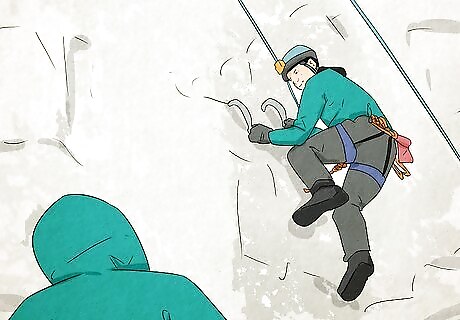
Start learning the ins and outs of climbing a mountain. Look for introductory courses in your area you can take and sign up for one. If you can’t find any, look online for courses you can take virtually. They’ll give you some of the fundamental tools and knowledge you’ll need to climb a mountain safely and successfully. Mountaineering uses a lot of different terms and lingo that a course can help you learn as well. The American Alpine Club offers courses in locations around the US that you can take to get a crash course on mountain climbing.
Join a climbing club in your region.
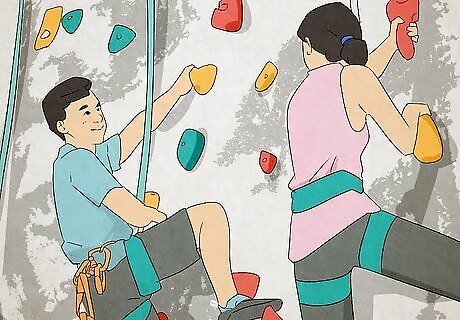
It’s a great way to meet other climbers. Many clubs and regional chapters are national groups such as the American Alpine Club are really welcoming to beginners. Look online to find a club in your area and see what you can do to join it. Go to meetings and group activities to meet up with other climbers who can give you tips and pointers as you’re learning the ropes. You can also look for online groups on places such as social media that you can join to chat with other climbers.
Get yourself in climbing shape.

Start working out 3 months to a year in advance of your climb. Mountain climbing is physically demanding, so building up your strength and conditioning is a great way to prep for a climb. If you haven’t worked out for years, start training at least a year in advance. If you’re already really active, 3-6 months of training may be enough. Work on both your strength and aerobic capacity and be sure to include climbing-specific exercises to simulate the movements you’ll use when you’re out on the mountain. For aerobic exercises, try running, cycling, or high-intensity interval training (HIIT). Lifting weights is a great way to build up your strength, but if you’re new to it, work with an experienced partner to make sure you don’t get hurt. Climbing-specific exercises you can do include step-ups, step-downs, lunges, squats, planks, and leg raises.
Go hiking with a weighted pack.
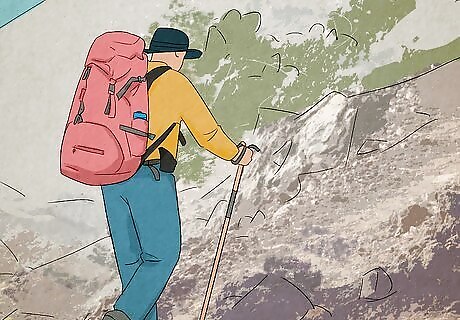
Simulate the physical demands of mountain climbing. Put on a backpack loaded down with gear or weights. Go hiking uphill with the pack on to build up your climbing muscles and physical conditioning so you’ll be better prepared for mountaineering. If you live near snow, go hiking uphill through the snow to build up your alpine climbing ability. Look for hiking trails in your area that you can check out. It’s a great way to enjoy nature and prep for your mountain climbing trip at the same time. Add in hiking with a weighted pack to your general training approach to mix things up.
Get all of the right mountaineering gear.

Make sure you have everything you need to climb a mountain safely. Check out a mountaineering supply store in your area. Try on a few different pairs of hiking boots or shoes to find a pair that you like. If you’re planning on scaling sections of a mountain, make sure you have a harness that fits you super well. You’ll also need some sturdy climbing ropes to use as well. For snowy conditions, get crampons, which are spikes that attach to your boots to give them more grip, as well as an ice axe. Make sure the boots fit comfortably! You’ll be wearing them for a long time so you don’t want your feet feeling cramped or squished. Hiking boots and shoes can be made of leather, synthetics, or waterproof membrane. Leather can be heavier but more durable, synthetics are lighter but may break down more quickly, and waterproof membrane are designed to resist water. Choose a material that best suits your needs. Use rope that’s rated and designed for mountain climbing. You want to be able to depend on it when you need it most.
Choose a route that suits your skill level.
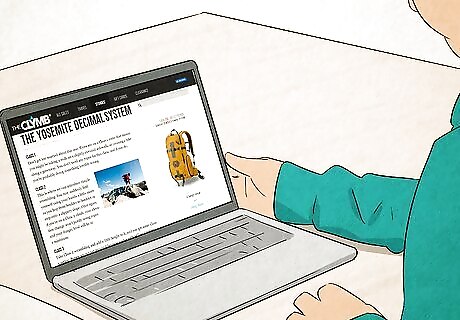
Climbing routes are rated based on their difficulty. The 2 main rating systems in North America are the Yosemite Decimal System (YDS) and the National Climbing Classification System (NCCS). The YDS uses a “class” system, rating from Class 1, which is the easiest, to Class 5, which is the most difficult. The NCCS bases their system on how long a climb is expected to take and uses a “grade” system. Grade I is the easiest and should take less than half a day to complete, while a Grade VII is the hardest and involves climbing large alpine walls. Choose a route that is appropriate for your experience level. For instance, if you’re brand new to mountain climbing, stick to Class 1 or Grade I routes.
Find out if you need a permit to climb the mountain.
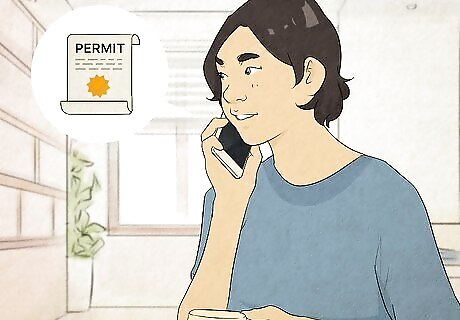
Some areas require special permission. Contact the park ranger’s office or check out their website to see what permits and fees they require. Make sure you pay the fee and secure the permit before you arrive at the mountain so you can focus on climbing when you get there. Most parks accept payment online. Keep your receipt just in case you need to use it as proof that you paid the required fee.
Acquire a bivouac permit if you plan to spend the night.

You may need permission to camp out on the mountain. A bivouac is a small, open-air campsite. Most parks and mountains require some sort of permit or license in order to set one up on a mountain or trailhead. Look into a specific mountain’s requirements and be sure to secure any necessary permissions or permits that you need before you start climbing. Check the park’s website or give the local Wilderness Office a call to see what you need to submit for a bivouac permit. Most parks will also require a parking permit for your vehicle, which you can pick up from the office.
Partner up with more experienced climbers.
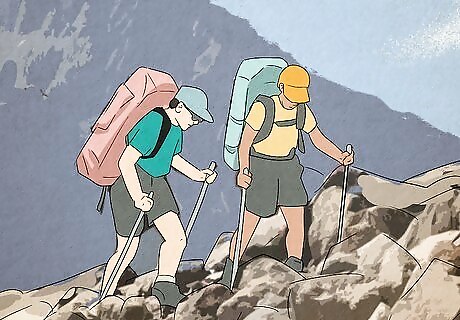
Ask lots of questions and learn as much as you can. Ask to join other, more experienced climbers if you can. They’ll help make sure you’re doing things right and can answer questions and give you pointers to improve your climbing skills. Take advantage of their experience! Watch what they do, ask questions, and absorb as much as you possibly can. For instance, if you notice that an experienced climber seems to be moving slower than you expect, ask them why. They may be pacing themselves to save energy.
Hire a guide to take you if you want a professional.

They can give you hands-on experience and keep you safe. If you want to take a guided trip, contact a company that’s licensed to operate guided services. Schedule your trip through them and you’ll have the help of an experienced professional who can make sure you’re safe and teach you how to properly climb a mountain. A few reputable companies that provide guided trips include Alpine Ascents International, International Mountain Guides, LLC, and Rainier Mountaineering, Inc.
Set mini-goals to keep your brain engaged.
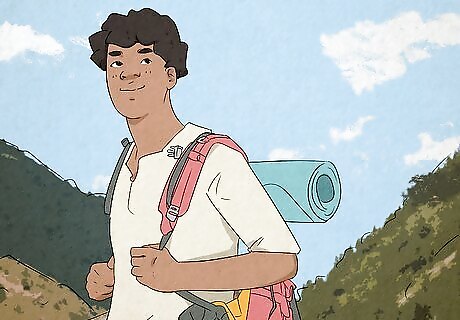
Mountain climbing is mentally demanding, too. While you’re out there, you may be tired, sore, dehydrated, hungry, and just generally uncomfortable. Try playing mental games like counting your steps. Look up at the top of the summit, walk for 100 steps (or whatever number you want), then pause for a few breaths. It’ll help you stay focused and the small accomplishments can keep you motivated.
Pace yourself as you make your way up the summit.
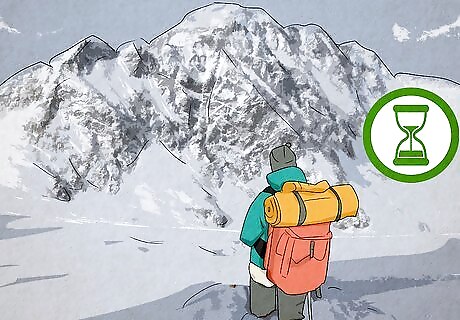
Save enough energy for the climb back, too. Start off moving slower than you think you should and stay at a steady pace on your climb up the mountain. That way, you’ll have plenty of energy left to make it back to your car or campsite once you make it to the top. It’s easy to get super excited and start moving as quickly as you can up the mountain. But you don’t want to find yourself stuck and exhausted at the top of a mountain.
Leave no traces behind.
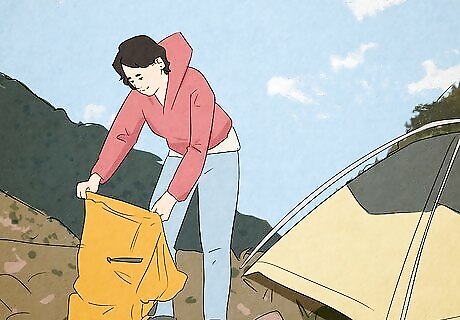
Be respectful of the mountain’s environment and wildlife. Use good climbing ethics whenever you’re out climbing. Pick up all of your litter and bury any human waste away from water. Be considerate of animals and wildlife and try to leave the rock and environment in its natural condition, a.k.a. looking the same as it was when you found it. Enjoy your time climbing, and leave no signs that you were there to maintain the environment and so others can enjoy climbing, too.
















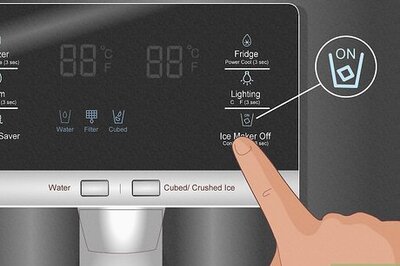

Comments
0 comment